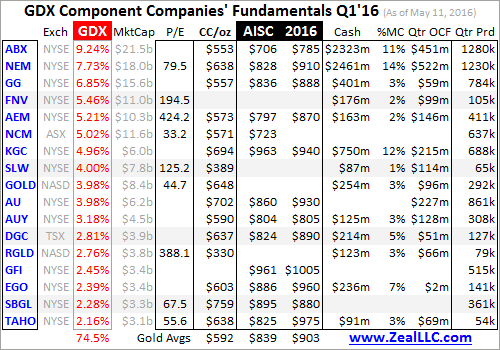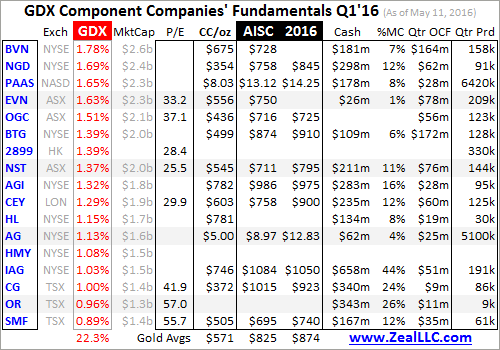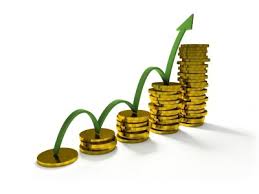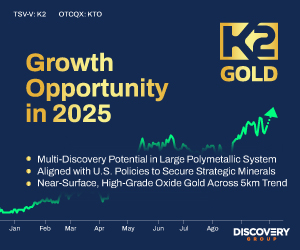The gold miners’ stocks have skyrocketed this year as investors started returning to this long-abandoned sector. Many have doubled since January, with plenty tripling or even quadrupling. Naturally such fast gains raise concerns about whether they are actually fundamentally justified or merely the product of fleeting sentiment that could reverse. Gold miners’ latest quarterly results offer great fundamental insights.
Companies trading on the US stock markets are required by the Securities and Exchange Commission to file quarterly earnings reports four times a year. For normal quarters that don’t end fiscal years, these 10-Q reports are due 45 calendar days after quarter-ends. They are a great boon to financial-market transparency and investors seeking to understand companies, yielding a treasure trove of information.
The gold miners are no exception, so about 6 weeks after quarter-ends I eagerly look forward to digging into their latest quarterly reports to see how they are faring. I’d love to analyze these results sooner, but this industry has always inexplicably pushed the limits of that 45-day legal window for filing. That’s irritating in this era of computerized accounting systems that can instantly produce real-time data on demand.
Given the extraordinary market events of the first quarter of 2016, it’s an exceedingly important one to understand what’s going on with the gold miners fundamentally. Q1’16 saw the flagship NYSE Arca Gold BUGS Index better known by its symbol HUI blast up a staggering 60.3%! While that was driven by gold powering 16.1% higher, the mining stocks’ 3.7x upside leverage to their metal was still quite high.
The most-popular gold-stock investment vehicle remains Van Eck’s GDX VanEck Vectors Gold Miners ETF. With a composition very similar to that venerable benchmark HUI, GDX enjoyed one heck of a Q1 as well with a huge 45.6% gain. This dominant gold-stock ETF doesn’t really have any meaningful competition, with assets running 38.2x those of the next-largest normal 1x long major-gold-miners ETF.
Thus the gold miners GDX’s managers include in their leading ETF are the definitive list of this sector’s biggest and best. While individual gold miners’ weightings in GDX are constantly tweaked, and smaller component companies are replaced from time to time, GDX inclusion is this industry’s gold standard. So that’s where I go every quarter to get my population of major gold miners to analyze their quarterly results.
As of the middle of this week, GDX had 39 holdings. These elite gold miners are overwhelmingly traded in the US stock markets, with 78.9% of this ETF’s weighting. That’s followed by Australia at 11.0% and Canada at 6.9%. I was glad to see the weighting of Chinese companies trading in Hong Kong fall under 2.0%. Chinese financial-reporting standards are atrocious, with muddled opaqueness defying belief.
Before I founded Zeal over 16 years ago, I was a certified public accountant working at a Big Six firm auditing publicly-traded mining companies. Ever since, I’ve been deeply immersed in researching this contrarian sector for investment and speculation. And even with this exceptional background, I find the Chinese quarterly reports utterly confounding. It’s not a language thing, they intentionally obscure key data.
But thankfully the American, Canadian, and Australian gold miners that dominate this industry tend to do an excellent job with their quarterly reports. They transparently provide an abundance of key data going far beyond legal SEC reporting requirements. That helps investors understand what is actually going on with their companies fundamentally, critical knowledge that is essential for success in this realm.
Every quarter I dig through these reports and fill a spreadsheet with a wide array of data from the results. This helps me decide which elite gold miners I want to invest in, and equally importantly which I’d rather avoid for a variety of reasons. These tables summarize some key data from GDX’s top 34 holdings, or 96.7% of this leading gold-stock ETF’s weightings. That’s how many happen to fit in our standard chart size.
Each company’s symbol and exchange listing purchased by GDX’s managers is followed by its weight in that ETF, and its market capitalization as of the middle of this week. GDX largely weights components by market cap, which is certainly the most logical way to do it. Market cap is actually an important thing to consider for investing, as the larger a company is the more capital inflows it will need to propel it higher.
That’s followed by price-to-earnings ratios, the foundation of fundamental analysis. Throughout all the stock markets, all stocks eventually migrate to some reasonable multiple of their underlying companies’ corporate profits. As I’ll discuss below, the gold miners’ P/E ratios look absolutely abysmal today. These companies are either showing GAAP losses or profits so trivial that they lead to ridiculously-high P/Es.
Naturally gold-mining profitability is purely a function of prevailing gold prices relative to the costs of actually producing this metal. The next few columns show the GDX miners’ cash costs per ounce and all-in sustaining costs per ounce in Q1’16, as well as their AISC outlooks for full-year 2016. The greater the delta between mining costs and gold prices, the more profitable these elite gold miners will become.
The next few columns look at key measures of financial health including cash on hand at the end of Q1, its percent of companies’ market capitalizations for a relative measure, and the critical cash generated by operations in Q1. Finally that’s followed by quarterly production, in ounces of gold for GDX’s gold miners. If silver miners broke out their gold separately, I included that alone. If not, it’s Q1 silver production.
Any number under 1500k ounces is gold, anything over is silver. But obviously silver-mining costs are excluded from the gold-mining averages discussed in this essay. Cells are left blank where data wasn’t available. The South African miners, for example, report in half-year increments so there is very little if any data available for Q1s and Q3s. The gold-mining industry actually fared very well fundamentally in Q1’16!


Before we get to the bullish stuff, let’s discuss the elephant under the rug. Investors buying gold miners are generally a hardcore contrarian lot, and that means they care deeply about valuations. But with fully half of these elite GDX gold miners showing trailing-twelve-month losses, and the other half sporting a crazy average P/E of 95.6x earnings, you’d think these were technology stocks where no one cares at all!
As discussed in depth in my previous essay on gold miners’ Q4’15, that bleak quarter was one of the toughest they’ve ever witnessed. Gold averaged just $1105, which was its lowest quarterly average since all the way back in Q4’09. And gold was crushed to a dismal 6.1-year secular low of $1051 right after the Fed’s first rate hike in 9.5 years in mid-December. These lows forced widespread asset write-downs.
One of the core principles of accounting we CPAs must adhere to is conservatism. We’re required to anticipate future losses but not future gains. And with Q4’s average gold prices at 6-year lows, existing gold mines and deposits were much less economical than at preceding years’ higher prevailing gold prices. Some gold simply couldn’t be mined profitably at $1100, and all the rest would be less profitable.
So regardless of what gold-mining executives believed about the gold-price outlook, they were forced to take big write-downs assuming $1100-or-lower gold was the new norm indefinitely. These losses have no cash component whatsoever, they are truly an accounting fiction. And once assets are written down to lower carrying values, they are never increased again per conservatism no matter how high gold goes.
These massive non-cash write-downs under the assumption gold would never rally again dwarfed the impressive operating profits the gold miners were actually earning even in dark Q4’15. Thus this entire sector is now showing trailing-twelve-month accounting losses or small profits after these write-downs. But gold mining’s nonexistent and high P/E ratios mask what is really happening on the operating front.
As these write-downs gradually roll off of the latest four quarters’ results used to calculate standard TTM P/E ratios, the gold miners’ P/Es will plummet dramatically to reflect their actual costs compared to the prevailing gold prices. I included this P/E column this week for a reference point when that happens in the coming quarters. Gold-stock valuations actually fall in gold bulls even while gold-stock prices soar!
That happens because gold-mining costs are largely fixed during each mine’s planning stages. That’s when mining engineers decide which ore bodies to extract, how to dig to them, and how to process that ore to recover the gold. So as prevailing gold prices rise, mining costs generally don’t rise with them. That leads to expanding profits not only greatly leveraging gold’s gains, but exceeding gold stocks’ appreciation.
Back in Q4’15 when gold stocks traded near fundamentally-absurd 13-year secular lows, this industry’s very viability and survival were widely called into question. Cash costs are the acid test of any gold miner’s survivability. They include all cash necessary to produce each ounce, which includes all direct production costs, mine-level administration, smelting, refining, transport, regulatory, royalty, and tax expenses.
In Q1’16, the elite GDX gold miners’ average cash cost per ounce of gold was just $583. That’s actually a slight 0.7% improvement from Q4’15’s $587 despite higher gold prices. The gold-mining industry as it exists today would have no problem surviving all the way down to $600 gold! That 6-year secular low in mid-December was never a threat, and no conceivable gold correction in the coming years will be one either.
But cash costs have always been problematic and misleading. It takes vast amounts of capital to find and develop gold deposits into operating mines, and to replace that gold as it’s naturally depleted. Cash costs include none of these outlays absolutely critical to gold-mining economics. Even more glaringly in some ways, they don’t include corporate-level administration! And those upper managers don’t come cheap.
So back in June 2013, the gold miners’ industry group the World Gold Council introduced a far-superior measure called all-in sustaining costs. This has universally spread in recent years, greatly accelerated by gold’s brutal central-bank-conjured bear market where gold-mining sustainability became investors’ primary concern. Today the great majority of gold miners report all-in sustaining costs, which is very helpful.
Along with all the direct cash costs of mining gold, all-in sustaining costs add everything necessary to maintain and replenish operations at current production levels. That includes costs for exploration for new gold to mine, mine development and construction expenses, remediation, reclamation, and of course corporate-level administration. They reflect the true costs of maintaining an ongoing gold-mining concern.
These elite GDX gold miners reported average AISC in Q1’16 of just $833 per ounce! That was also a slight 0.4% improvement from Q4’15’s $836. Think about the implications of this important fundamental revelation. In a quarter where the average gold price climbed 7.3% to $1185, gold miners’ AISC were dead flat! That means their operating profits improved dramatically in Q1, which TTM P/E ratios don’t yet reflect.
The GDX gold miners’ margins soared from $269 per ounce in Q4 to $352 per ounce in Q1, large 31.1% growth on that mere 7.3% advance in prevailing gold prices! And if Q1’s average all-in sustaining costs hold into Q2, gold-mining profits will continue to explode. As of the middle of this week, the gold price has averaged $1252 so far in Q2. That implies $419 per ounce in profits, which is another 19.1% higher.
Just like during every past major bull market in gold, gold-mining earnings are rocketing higher far faster than the gold price. That’s simply the way the math always works due to the inherent profits leverage of gold mining to higher gold prices. As gold continues its long-overdue mean reversion higherout of the anomalously-low central-bank distortions of recent years, gold-mining profitability will soar incredibly.
And P/E ratios will absolutely reflect this once Q4’15’s big non-cash write-downs roll off the latest four quarters’ results. Some companies’ P/E ratios will improve even sooner than Q4’16 since they took write-downs earlier last year instead of waiting until the end. So gold-stock valuations based on the standard trailing-twelve-month price-to-earnings ratios will certainly look radically better in the coming quarters.
These elite gold miners don’t expect their costs to rise much either, with current average projections of $890 AISC for all of 2016. While that is 6.9% higher than Q1’s AISC, it’s not a concern. Investors have become very cost-conscious in recent years, so managements want to exceed their expectations on cost projections. Thus they tend to overestimate AISC early in the year, to yield easier targets to beat later.
Note above almost all Q1’16 AISCs were well below 2016 projections. And the improving gold prices finally give the miners some breathing room on the exploration and mine-expansion fronts. Increased capital expenditures this year will flow into all-in sustaining costs. But that is very healthy for this industry since it replenishes the reserves necessary to maintain and even expand current production levels.
One more point on future profitability. The last normal year for gold before those wildly-unprecedented central-bank distortions between 2013 to 2015, levitating stock markets sapping alternative-investment demand, was 2012. That was an unremarkable year for gold, a weaker correction/consolidation year well under 2011’s secular-bull highs. Yet the gold price still averaged $1669 even in that environment.
A mean reversion back up to those 2012 levels even at $900 AISC would lead to staggering operating profits of $769 per ounce for the elite gold miners! That’s nearly triple what was seen in Q4. So gold-mining earnings, which ultimately determine gold-mining stock prices, have vast room to run before they near topping levels. Q1’16 decisively proved the gold miners are thriving again on the fundamental front.
That’s also evident in these tables’ next set of columns that includes quarterly operating cash flows for these GDX gold miners. The majority saw their operations generate strong positive cash flows in Q1, which is exactly what you’d expect given the growing gulf between gold miners’ costs and prevailing gold prices. This excellent cash generation fed the hefty cash treasuries seen at many of the GDX components.
Back in Q4’15 with gold near major secular lows, cash was seen as an important survivability metric. As long as the gold miners weren’t burning through their cash too fast, they could weather those gold lows. It was rather ironic that the gold miners were still generating impressive operating cash flows even in that trough quarter, as I pointed out a few months ago. Q1’16 has seen that focus abruptly shift to expansion.
After years of being forced to curtail their exploration and development budgets, the gold miners can finally start planning to invest on these critical fronts for future growth. Funded by the strengthening operating cash flows they’re generating, and their large cash hoards, these capital investments will lead to higher future production for the gold miners. That will boost their profits and further lower their valuations.
The last column in these tables is quarterly production. These top 34 components of GDX collectively mined 9717k ounces in Q1. That works out to 302.2 metric tons. According to the World Gold Council’s brand-new report on Q1’16’s global gold supply-and-demand fundamentals just released yesterday, the total world mine production was 734.0t last quarter. So these elite GDX miners accounted for 41.2% of that.
That means this latest fundamental read on the state of the gold-mining industry is representative. With all-in sustaining costs way down near $833 per ounce on average, the gold miners’ profits will continue to surge as gold mean reverts higher. And even when gold corrects, which is inevitable in any healthy ongoing bull market, gold won’t plunge anywhere near low enough to pose any threat to their ongoing viability.
The elite gold miners’ excellent Q1’16 results prove that gold stocks’ massive gains so far this year are indeed fundamentally justified to a great extent. While gold stocks’ mighty new bull has really outpaced earnings growth, that is a righteous mean-reversion thing as I’ve recently written extensively about. The trough gold-stock prices were fundamentally-absurd relative to prevailing gold prices, so they couldn’t last.
With such a large gulf already opening up between gold-mining costs on an all-in-sustaining basis and current gold prices, investors can safely assume this new gold-stock bull has a long ways to run yet. It certainly won’t be a straight shot higher from here, but the biggest gains are almost certainly still yet to come. Major gold bulls tend to run for years, which gold miners amplify due to their inherent profits leverage.
So investors wanting to multiply their wealth as this young new bull matures should take advantage of any weakness in this volatile sector to deploy capital. GDX will perform well, but its upside potential will be dwarfed by the best of the individual gold miners. The largest miners dominating GDX’s weightings will see smaller gains simply due to the inertia of their big market caps, and this ETF is over-diversified as well.
So at Zeal we rely on our decades of experience and ongoing deep research to deploy into the higher-potential mid-tier and smaller gold miners. We currently have open trades in just 5 and 8 of these top GDX components in our acclaimed monthly and weekly newsletters, along with 8 and 11 more elite gold and silver stocks not in this list. Our unrealized gains include many doublings and triplings in recent months!
Why not own the fundamentally-superior gold miners instead of the entire sector through GDX? We’ve spent 16+ years intensely studying and actively trading this high-potential contrarian sector, so our expertise is unparalleled. Over the decades we’ve helped our subscribers multiply their wealth with many hundreds of gold-stock and silver-stock trades. Our newsletters draw on our vast experience, knowledge, wisdom, and ongoing research to explain what’s going on in the markets, why, and how to trade them with specific stocks. They will help you learn to think, trade, and thrive like a contrarian for just $10 per issue. Subscribe today!
The bottom line is the gold miners’ fundamentals were very strong in just-reported Q1’16. Despite the powerful new gold bull this year, their low all-in sustaining costs didn’t even rise. Way down at an average of just $833 per ounce, the operating profitability of the gold-mining industry is already surging to leverage gold’s advance. Eventually these rapidly-rising earnings will be reflected in falling P/Es.
Gold-mining valuations look the worst after major secular gold lows, due to the non-cash write-downs they spawn. Then as gold shifts from bear to bull mode, profits rise faster than stock prices on balance pushing valuations down. This will become evident as this year’s sharp initial mean-reversion-rebound gains moderate. The gold miners’ strong Q1’16 results prove their stocks’ big gains are fundamentally justified.
Adam Hamilton, CPA
May 13, 2016 Zeal Intelligence
related:
Good Times Roll For Junior Gold Stocks



 “How many millionaires do you know who have become wealthy by investing in savings accounts? I rest my case.”
“How many millionaires do you know who have become wealthy by investing in savings accounts? I rest my case.”


















